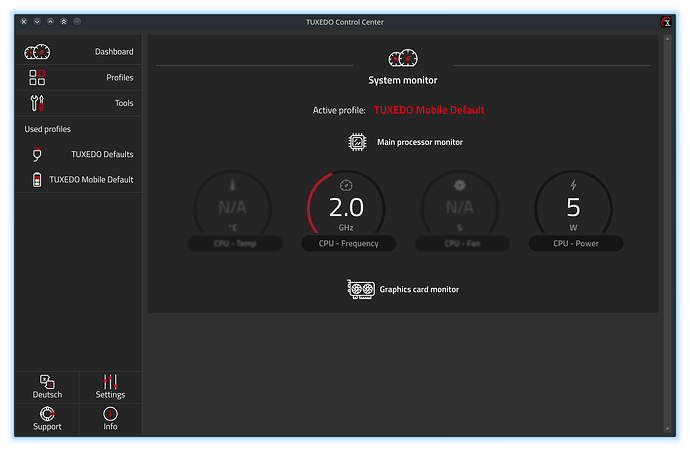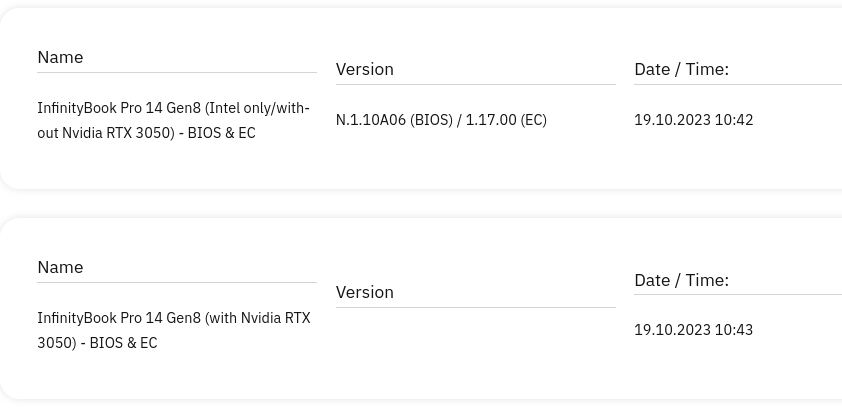I’ve got a TUXEDO InfinityBook Pro 14 Gen 8, with the TUXEDO OS preinstalled. The laptop has an integrated Intel Iris Xe and an NVIDIA GeForce RTX 3050 6GB.
Everything worked smoothly and quite well, but the OS is Ubuntu based and I started to have too many problems in configuring some software which is only available as a flatpack (not to mention language/locale problems, which I could not debug even after reading several posts about it).
As a Manjaro user since 2016, I decided to switch to it, especially after being told by the customer service that it should work fine after installing TUXEDO’s software and drivers provided by the Manjaro’s official repos and AUR.
However, I’m currently facing several issues, the most significant of which is related to the graphics card. I am unable to adjust the screen resolution or scale factor. Every time I try to do it, I get a black screen, and the only solution is to reboot via a TTY.
List of installed video card drivers (obtained via mhwd -li in the terminal):
Installed PCI configs:
--------------------------------------------------------------------------------
NAME VERSION FREEDRIVER TYPE
--------------------------------------------------------------------------------
video-modesetting 2020.01.13 true PCI
video-hybrid-intel-nvidia-prime 2023.03.23 false PCI
Warning: No installed USB configs!
My hardware configuration shows the following:
And the output of glxinfo | grep renderer is
OpenGL renderer string: NVIDIA GeForce RTX 3050 6GB Laptop GPU/PCIe/SSE2
I suppose this command lists the graphics card used by default, right? Shouldn’t it be Intel?
In addition, TUXEDO Control Center does not show any info related to the NVIDIA GPU, and it used to do when I was using TUXEDO OS:
I have already installed the tuxedo-drivers-dkms package.
How can I properly configure the graphics card?
[I have other concerns, but this is the most relevant at the moment.]
Details about my system obtained with inxi -Fazy:
Output
System:
Kernel: 6.7.0-0-MANJARO arch: x86_64 bits: 64 compiler: gcc v: 13.2.1
clocksource: tsc available: acpi_pm
parameters: BOOT_IMAGE=/@/boot/vmlinuz-6.7-x86_64
root=UUID=d389c6f1-9bfe-4eff-a4c9-4964e7d6f10d rw rootflags=subvol=@ quiet
splash udev.log_priority=3
Desktop: KDE Plasma v: 5.27.10 tk: Qt v: 5.15.12 wm: kwin_x11 vt: 2
dm: SDDM Distro: Manjaro Linux base: Arch Linux
Machine:
Type: Laptop System: TUXEDO product: TUXEDO InfinityBook Pro Gen8 (MK2)
v: Standard serial: <superuser required>
Mobo: NB02 model: PH4PG31 v: Standard serial: <superuser required>
UEFI: American Megatrends LLC. v: N.1.10A06 date: 09/25/2023
Battery:
ID-1: BAT0 charge: 66.5 Wh (67.0%) condition: 99.2/99.2 Wh (100.0%)
volts: 15.9 min: 15.5 model: standard type: Li-ion serial: <filter>
status: discharging
CPU:
Info: model: 13th Gen Intel Core i7-13700H bits: 64 type: MST AMCP
arch: Raptor Lake gen: core 13 level: v3 note: check built: 2022+
process: Intel 7 (10nm) family: 6 model-id: 0xBA (186) stepping: 2
microcode: 0x411C
Topology: cpus: 1x cores: 14 mt: 6 tpc: 2 st: 8 threads: 20 smt: enabled
cache: L1: 1.2 MiB desc: d-8x32 KiB, 6x48 KiB; i-6x32 KiB, 8x64 KiB
L2: 11.5 MiB desc: 6x1.2 MiB, 2x2 MiB L3: 24 MiB desc: 1x24 MiB
Speed (MHz): avg: 449 high: 846 min/max: 400/4800:5000:3700 scaling:
driver: intel_pstate governor: powersave cores: 1: 400 2: 400 3: 400 4: 400
5: 400 6: 400 7: 400 8: 400 9: 400 10: 400 11: 598 12: 400 13: 400 14: 750
15: 400 16: 846 17: 400 18: 400 19: 400 20: 400 bogomips: 116780
Flags: avx avx2 ht lm nx pae sse sse2 sse3 sse4_1 sse4_2 ssse3 vmx
Vulnerabilities:
Type: gather_data_sampling status: Not affected
Type: itlb_multihit status: Not affected
Type: l1tf status: Not affected
Type: mds status: Not affected
Type: meltdown status: Not affected
Type: mmio_stale_data status: Not affected
Type: retbleed status: Not affected
Type: spec_rstack_overflow status: Not affected
Type: spec_store_bypass mitigation: Speculative Store Bypass disabled via
prctl
Type: spectre_v1 mitigation: usercopy/swapgs barriers and __user pointer
sanitization
Type: spectre_v2 mitigation: Enhanced / Automatic IBRS, IBPB: conditional,
RSB filling, PBRSB-eIBRS: SW sequence
Type: srbds status: Not affected
Type: tsx_async_abort status: Not affected
Graphics:
Device-1: Intel Raptor Lake-P [Iris Xe Graphics] vendor: Tongfang Hongkong
driver: i915 v: kernel arch: Gen-13 process: Intel 7 (10nm) built: 2022+
ports: active: eDP-1 empty: DP-1,DP-2,HDMI-A-1 bus-ID: 00:02.0
chip-ID: 8086:a7a0 class-ID: 0300
Device-2: NVIDIA GN20-P0-R-K2 [GeForce RTX 3050 6GB Laptop GPU]
vendor: Tongfang Hongkong driver: nvidia v: 545.29.06
alternate: nouveau,nvidia_drm non-free: 545.xx+ status: current (as of
2023-11; EOL~2026-12-xx) arch: Ampere code: GAxxx process: TSMC n7 (7nm)
built: 2020-2023 pcie: gen: 4 speed: 16 GT/s lanes: 8 link-max: lanes: 16
ports: active: none empty: DP-3 bus-ID: 01:00.0 chip-ID: 10de:25ac
class-ID: 0300
Device-3: SunplusIT FHD Webcam driver: uvcvideo type: USB rev: 2.0
speed: 480 Mb/s lanes: 1 mode: 2.0 bus-ID: 3-6:2 chip-ID: 2b7e:c757
class-ID: 0e02 serial: <filter>
Display: x11 server: X.Org v: 21.1.10 compositor: kwin_x11 driver: X:
loaded: modesetting,nvidia dri: iris gpu: i915 display-ID: :0 screens: 1
Screen-1: 0 s-res: 2880x1800 s-dpi: 75 s-size: 978x611mm (38.50x24.06")
s-diag: 1153mm (45.4")
Monitor-1: eDP-1 mapped: eDP-1-1 model-id: CSO 0x140c built: 2021
res: 2880x1800 hz: 90 dpi: 242 gamma: 1.2 size: 302x188mm (11.89x7.4")
diag: 356mm (14") ratio: 16:10 modes: 2880x1800
API: EGL v: 1.5 hw: drv: intel iris drv: nvidia platforms: device: 0
drv: nvidia device: 1 drv: iris device: 3 drv: swrast surfaceless:
drv: nvidia x11: drv: nvidia inactive: gbm,wayland,device-2
API: OpenGL v: 4.6.0 compat-v: 4.5 vendor: nvidia mesa v: 545.29.06
glx-v: 1.4 direct-render: yes renderer: NVIDIA GeForce RTX 3050 6GB Laptop
GPU/PCIe/SSE2 memory: 5.86 GiB
API: Vulkan v: 1.3.274 layers: 1 device: 0 type: discrete-gpu name: NVIDIA
GeForce RTX 3050 6GB Laptop GPU driver: nvidia v: 545.29.06
device-ID: 10de:25ac surfaces: xcb,xlib
Audio:
Device-1: Intel Raptor Lake-P/U/H cAVS vendor: Tongfang Hongkong
driver: snd_hda_intel v: kernel alternate: snd_sof_pci_intel_tgl
bus-ID: 00:1f.3 chip-ID: 8086:51ca class-ID: 0403
Device-2: NVIDIA vendor: Tongfang Hongkong driver: snd_hda_intel v: kernel
pcie: gen: 4 speed: 16 GT/s lanes: 8 link-max: lanes: 16 bus-ID: 01:00.1
chip-ID: 10de:2291 class-ID: 0403
API: ALSA v: k6.7.0-0-MANJARO status: kernel-api with: aoss
type: oss-emulator tools: alsactl,alsamixer,amixer
Server-1: JACK v: 1.9.22 status: off tools: N/A
Server-2: PipeWire v: 1.0.0 status: active with: 1: pipewire-pulse
status: active 2: wireplumber status: active 3: pipewire-alsa type: plugin
tools: pactl,pw-cat,pw-cli,wpctl
Network:
Device-1: Intel Raptor Lake PCH CNVi WiFi driver: iwlwifi v: kernel
bus-ID: 00:14.3 chip-ID: 8086:51f1 class-ID: 0280
IF: wlo1 state: up mac: <filter>
Bluetooth:
Device-1: Intel AX211 Bluetooth driver: btusb v: 0.8 type: USB rev: 2.0
speed: 12 Mb/s lanes: 1 mode: 1.1 bus-ID: 3-10:3 chip-ID: 8087:0033
class-ID: e001
Report: rfkill ID: hci0 rfk-id: 0 state: up address: see --recommends
Drives:
Local Storage: total: 3.64 TiB used: 57.15 GiB (1.5%)
SMART Message: Unable to run smartctl. Root privileges required.
ID-1: /dev/nvme0n1 maj-min: 259:0 vendor: Samsung model: SSD 990 PRO 4TB
size: 3.64 TiB block-size: physical: 512 B logical: 512 B speed: 63.2 Gb/s
lanes: 4 tech: SSD serial: <filter> fw-rev: 0B2QJXG7 temp: 27.9 C
scheme: GPT
Partition:
ID-1: / raw-size: 3.64 TiB size: 3.64 TiB (100.00%) used: 57.14 GiB (1.5%)
fs: btrfs dev: /dev/nvme0n1p2 maj-min: 259:2
ID-2: /boot/efi raw-size: 300 MiB size: 299.4 MiB (99.80%)
used: 584 KiB (0.2%) fs: vfat dev: /dev/nvme0n1p1 maj-min: 259:1
ID-3: /home raw-size: 3.64 TiB size: 3.64 TiB (100.00%)
used: 57.14 GiB (1.5%) fs: btrfs dev: /dev/nvme0n1p2 maj-min: 259:2
ID-4: /var/log raw-size: 3.64 TiB size: 3.64 TiB (100.00%)
used: 57.14 GiB (1.5%) fs: btrfs dev: /dev/nvme0n1p2 maj-min: 259:2
Swap:
Alert: No swap data was found.
Sensors:
System Temperatures: cpu: 37.0 C mobo: N/A gpu: nvidia temp: 38 C
Fan Speeds (rpm): N/A
Info:
Processes: 426 Uptime: 1h 25m wakeups: 0 Memory: total: 32 GiB note: est.
available: 31.09 GiB used: 7.75 GiB (24.9%) Init: systemd v: 255
default: graphical tool: systemctl Compilers: gcc: 13.2.1 clang: 16.0.6
Packages: pm: pacman pkgs: 1266 libs: 358 tools: pamac pm: flatpak pkgs: 0
Shell: Zsh v: 5.9 default: Bash v: 5.2.21 running-in: konsole inxi: 3.3.31



